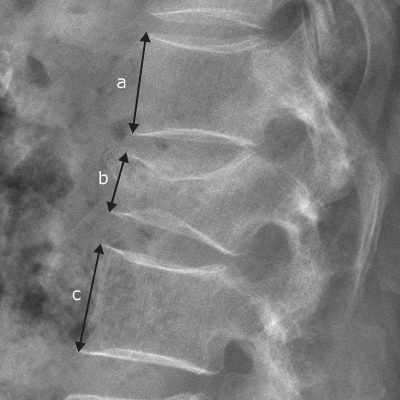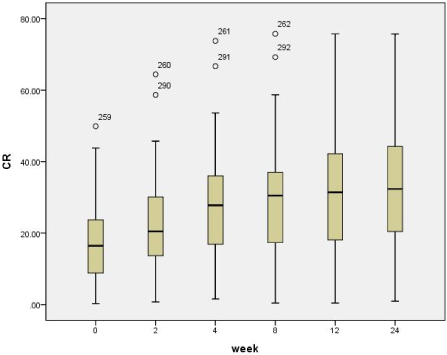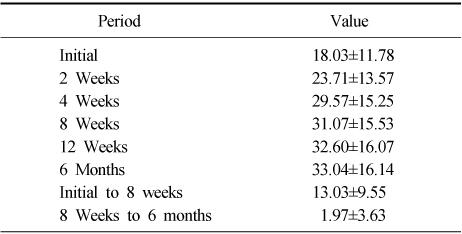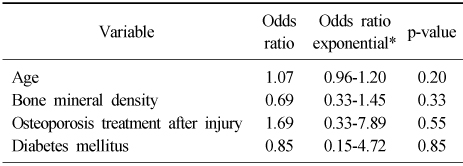Articles
- Page Path
- HOME > J Musculoskelet Trauma > Volume 28(2); 2015 > Article
-
Original Article
- Progression of Compression and Related Factors in Conservative Management of Osteoporotic Vertebral Compression Fractures
- Young Do Koh, M.D., PhD., Jeong Soo Park, M.D.
-
Journal of the Korean Fracture Society 2015;28(2):132-138.
DOI: https://doi.org/10.12671/jkfs.2015.28.2.132
Published online: April 21, 2015
Department of Orthopaedic Surgery, Ewha Womans University School of Medicine, Seoul, Korea.
- Address reprint requests to: Young Do Koh, M.D. Department of Orthopaedic Surgery, Ewha Womans University Mokdong Hospital, 1071 Anyangcheon-ro, Yangcheon-gu, Seoul 158-710, Korea. Tel: 82-2-2650-5564, Fax: 82-2-2642-0349, ydkoh@ewha.ac.kr
Copyright © 2015 The Korean Fracture Society. All rights reserved.
This is an Open Access article distributed under the terms of the Creative Commons Attribution Non-Commercial License (http://creativecommons.org/licenses/by-nc/3.0/) which permits unrestricted non-commercial use, distribution, and reproduction in any medium, provided the original work is properly cited.
- 181 Views
- 1 Download
- 5 Crossref
Figure & Data
REFERENCES
Citations

- The Factors between the Progression of the Compression Rate and Magnetic Resonance Imaging Findings in Osteoporotic Vertebral Fracture Patients Treated with Teriparatide
Taebyeong Kang, Seung-Pyo Suh, Jeongwoon Han, Byungjun Kang, Changhyun Park
Journal of the Korean Orthopaedic Association.2023; 58(5): 392. CrossRef - Effect of Weekly Teriparatide Administration Followed by Percutaneous Balloon Kyphoplasty on Post-Menopausal Osteoporotic Compression Fracture Treatment
Sung-Ha Hong, Seung-Pyo Suh, Woo Jin Shin, Seung Gi Lee, Byung Jun Kang
Journal of the Korean Orthopaedic Association.2022; 57(1): 35. CrossRef - Treatment Effect with Weekly Teriparatide in the Vertebral Compression Fractures in Patients with Severe Osteoporosis
Seok-Ha Hwang, Young-Kyun Woo, Ho-Seung Jeon, Seung-Pyo Suh, Joo-Young Kim, Jae-Nam Kim
Journal of the Korean Orthopaedic Association.2019; 54(6): 528. CrossRef - The Influence of Initial Magnetic Resonance Imaging Findings on the Compression Rate of Thoracolumbar Osteoporotic Vertebral Compression Fracture
Seok-Ha Hwang, Seung-Pyo Suh, Young-Kyun Woo, Ho-Seung Jeon, Ho-Won Jeong
Journal of the Korean Orthopaedic Association.2018; 53(4): 341. CrossRef - A Retrospective Clinical Survey of Vertebral Compression Fractures
Ji Hye Oh, Yun Kyu Lee, Jae Soo Kim, Hyun Jong Lee, Sung Chul Lim
Journal of Acupuncture Research.2018; 35(4): 219. CrossRef


Fig. 1
Fig. 2
Compression Rate (%) according to the Serial Follow-Up and Compression-Rate Progression on Initial to 8 Weeks and 8 Weeks to 6 Months (n=47)
Values are presented as mean±standard deviation.
Difference of Compression-Rate Increase and Change of Mean Slopes between Initial to 8 Weeks and 8 Weeks to 6 Months
p-value=0.00. *Mean±tandard devation. †Corresponding value±standard error.
Single Variable Analysis to Evaluate the Differences of Related Factors between Two Groups*
Values are presented as mean±standard deviation or number (%). *Compression-rate increase: below 15% group and more than 15% group.
Logistic Regression Analysis to Evaluate the Influence of Related Factors on the Compression-Rate Increases
*95% confidence interval.
Values are presented as mean±standard deviation.
p-value=0.00. *Mean±tandard devation. †Corresponding value±standard error.
Values are presented as mean±standard deviation or number (%). *Compression-rate increase: below 15% group and more than 15% group.
*95% confidence interval.

 E-submission
E-submission KFS
KFS






 Cite
Cite

